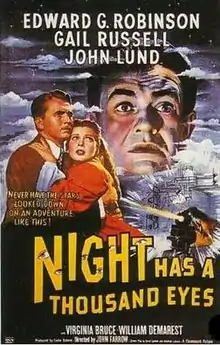Night Has a Thousand Eyes
Night Has a Thousand Eyes is a 1948 film noir, starring Edward G. Robinson and directed by John Farrow. The screenplay was written by Barré Lyndon and Jonathan Latimer. The film is based on the novel of the same name by Cornell Woolrich, originally published under the pseudonym George Hopley.[3]
| Night Has a Thousand Eyes | |
|---|---|
 Theatrical release poster | |
| Directed by | John Farrow |
| Produced by | Endre Bohem |
| Screenplay by | Barré Lyndon Jonathan Latimer |
| Based on | Night Has a Thousand Eyes by Cornell Woolrich |
| Starring | Edward G. Robinson Gail Russell John Lund Virginia Bruce |
| Music by | Victor Young |
| Cinematography | John F. Seitz |
| Edited by | Eda Warren |
| Distributed by | Paramount Pictures |
Release date |
|
Running time | 81 minutes |
| Country | United States |
| Language | English |
| Budget | $1.9 million[1] |
| Box office | $1.5 million (US rentals)[2] |
The film includes the original Angels Flight on Bunker Hill in Downtown Los Angeles as a location.
Synopsis
The film opens in New Orleans, where John Triton (Robinson) is "The Mental Wizard", a nightclub fortune teller. During a show one evening, Triton suddenly urges an audience member to rush home, cautioning that her son is in danger. As the story unfolds, Triton struggles with his new-found psychic ability, as all of his relentlessly bleak predictions prove accurate. Jerome Cowan (of Maltese Falcon fame) plays Whitney Courtland, Triton's best friend, who becomes wealthy using tips from the now-psychic Triton.
Cast
- Edward G. Robinson as John Triton "The Mental Wizard"
- Gail Russell as Jean Courtland
- John Lund as Elliott Carson
- Virginia Bruce as Jenny Courtland
- William Demarest as Lt. Shawn
- Richard Webb as Peter Vinson
- Jerome Cowan as Whitney Courtland
Reception
The film is generally praised for its gloomy adaptation of Woolrich's writing. In his book Art of Noir, Eddie Muller writes: "No film more faithfully captured Woolrich's sense of doomed predestination than Night Has a Thousand Eyes." Time Out Film Guide, however (in spite of praising the cinematography by John F. Seitz), gives the thriller a negative review:
"Aside from the fine opening sequence -- Lund's rescue of Gail Russell from the brink of suicide, and discovery of her mortal terror of the stars -- a disappointing adaptation of Cornell Woolrich's superb novel."[4]
Music
The film's main theme (written by Jerry Brainin and Buddy Bernier) became a jazz standard, having been recorded by Horace Silver, Carmen McRae, Harry Beckett, Paul Desmond and John Coltrane, among others.
References
Notes
- Joseph W. Taylor, Staff Correspondent, "Biggest Film Firm: Paramount's Puzzler: Will Attendance Slide Be Brief or Prolonged?", Wall Street Journal (New York, N.Y.), 21 July 1947: 1.
- "Top Grossers of 1948", Variety, January 5, 1949 p. 46.
- Night Has a Thousand Eyes at the American Film Institute Catalog.
- TimeOut film review, no date. Accessed July 5, 2013.
Bibliography
- Eddie Muller (2002). Art of Noir. Overlook Hardcover. ISBN 1-58567-073-1.
Streaming audio
- Night Has a Thousand Eyes on Screen Directors Playhouse: February 27, 1949
- Night Has a Thousand Eyes on Philip Morris Playhouse: August 19, 1953